

How did MyEclipse get their Maven Integration So Wrong? Eugene and I have been watching with amazement how vocal MyEclipse users have been about their great disappointment with Genuitec’s attempt at Maven integration, which amounts to complete mutilation of m2eclipse and the way Maven itself works.

Genuitec decided to work in their standard fashion, which is unfortunately not a very collaborative mode of operation, and it’s apparent that MyEclipse customers are not happy. MyEclipse Breaks Maven Maven has a very opinionated way of doing things, there is a very strong structure that is encouraged and users have come to like the convention over configuration approach. I warned Wayne Parrot from Genuitec that changing the way Maven worked by default, or at least the attempt to, would result in unhappy Maven users. None of our documentation would apply, users could not use conventional modes of support like the Maven users lists, or the m2eclipse users lists, and they couldn’t benefit from standard books, or the Maven website.
Guide to Creating Archetypes. Dependency Convergence in Maven. I was running in to a problem with a Java project that occured only in IntelliJ Idea, but not on the command line, when running specific test classes in Maven. The exception stack trace had the following in it: 1.Caused by: com.sun.jersey.api.container.ContainerException: No WebApplication provider is present That seems like an easy problem to fix - it is the exception message that is given when jersey can’t find the provider for JAX-RS.
Fixing it is normally just a matter of making sure jersey-core is on the classpath to fulfill SPI requirements for JAX-RS. For some reason though this isn’t happening in IntelliJ Idea. Maven: The Complete Reference: 3.6. POM Best Practices / Documentation Sonatype.com. 3 ways to run Java main from Maven. Overview.
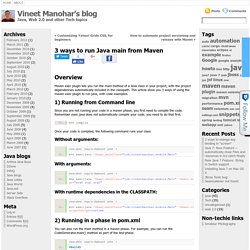
Repository Management with Nexus: 2.5. Adopting a Repository Manager / Documentation Sonatype.com. This section talks about the stages of moving to a repository manager.
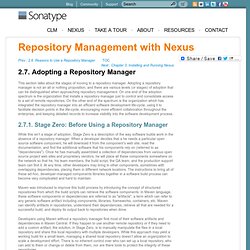
Adopting a repository manager is not an all or nothing proposition, and there are various levels (or stages) of adoption that can be distinguished when approaching repository management. On one end of the adoption spectrum is the organization that installs a repository manager just to control and consolidate access to a set of remote repositories. On the other end of the spectrum is the organization which has integrated the repository manager into an efficient software development life-cycle, using it to facilitate decision points in the life-cycle, encouraging more efficient collaboration throughout the enterprise, and keeping detailed records to increase visibility into the software development process.
Rob's Blog. We wanted to set up a nightly integration build with our projects so that we could run unit and integration tests on the latest version of our applications and their underlying libraries.
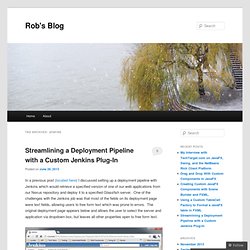
We have a number of libraries that are shared across multiple projects and we wanted this build to run every night and use the latest versions of those libraries even if our applications had a specific release version defined in their Maven pom file. In this way we would be alerted early if someone added a change to one of the dependency libraries that could potentially break an application when the developer upgraded the dependent library in a future version of the application. The chart below illustrates our dependencies between our libraries and our applications. Updating Versions Nightly Both the Crossdock-shared and Messaging-shared libraries depend on the Siesta Framework library. Creating a build pipeline using Maven, Jenkins, Subversion and Nexus. For a while now, we had been operating in the wild west when it comes to building our applications and deploying to production.
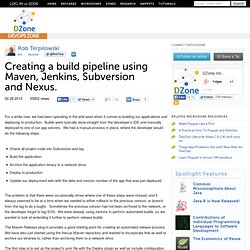
Builds were typically done straight from the developer’s IDE and manually deployed to one of our app servers. Hudson - Attaching Build Number for binaries in Maven. Eclipse - Getting error: Plugin execution not covered by lifecycle configuration with GWT. Creating Java domain objects with the Maven Hibernate plugin and Hibernate tools. « hop2croft's software development Blog. Mike Desjardins' Series of Tubes » java. One of the ancillary projects of the Hibernate framework is the Hibernate Tools toolset.
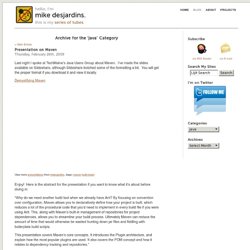
Using Hibernate Tools, you can automatically generate your mapping files (or, if you prefer, JPA annotations), POJOs, and DDL from your database schema. I’ve been enamored with the “Convention over Configuration” web frameworks lately (e.g., Grails, Django), and wondered how hard it’d be to reproduce some of their magic ORM functionality using Hibernate Tools. I’ve concluded that I’ve still got a long ways to go, but that I might have some worthwhile tips to share in the meantime. My progress has been impeded a bit because the documentation for Hibernate Tools is pretty weak. Hibernate Tools was really generated with Eclipse users in mind. 0.) I’m still in the dark ages – I use ant instead of maven for builds, and need to track down jar dependencies the old fashioned way. 1.) This is pretty straightforward, and it is explained fairly well in the documentation. 2.) 2.) Hope that helps! Creating Intelligent Projects with Maven. Creating Intelligent Projects with Maven This article covers core concepts of Apache Maven like the Project Object Model (POM), Build Lifecycle, Dependency Management, Repositories, and Plugins.
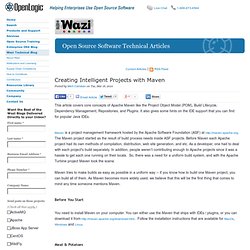
It also gives some hints on the IDE support that you can find for popular Java IDEs. Maven is a project management framework hosted by the Apache Software Foundation (ASF) at The Maven project started as the result of build process needs inside ASF projects. Before Maven each Apache project had its own methods of compilation, distribution, web site generation, and etc. As a developer, one had to deal with each project's build separately. Before You Start. Hosting Maven Repos on Github. UPDATE: If you’re using Clojure and Leiningen, read no further.

Just use s3-wagon-private to deploy artifacts to S3. Java - How do I get my Maven Integration tests to run.